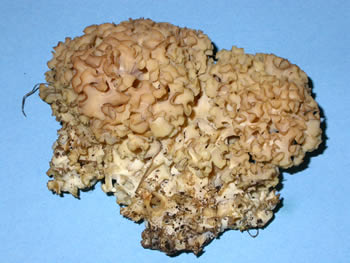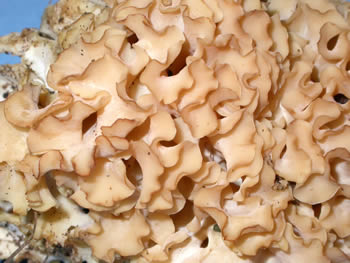Sparassis americana
Scientific name: Sparassis americana R. H. Petersen
Derivation of name: Sparass- means "to tear into
pieces," referring to the many thin, wavy, leaflike
branches; americana means the fungus was
named after the United States of America, which was
named after explorer Amerigo Vespucci.
Synonyms: Sparassis crispa (Wulfen) Fr.,
Sparassis radicata Weir
Common name(s): Rooting cauliflower mushroom, conifer
cauliflower mushroom, American cauliflower mushroom
Phylum: Basidiomycota
Order: Polyporales
Family: Sparassidaceae
Occurrence on wood substrate: Saprobic/parasitic; solitary
or in groups on the ground near conifer trunks or stumps or
sometimes on well-decayed conifer logs and stumps; August
through
October.
Dimensions: The entire complex mass of flattened branches
may be up to 40 cm and high and 20 cm (or more) wide.
Description: This fungus occurs as a compact cluster of
flattened, leaf-like branches (called
flabellae) which are highly
contorted ("crinkled"). The flabellae do not have distinct color
zonations (i.e., they are azonate) but the margins are typically
darkest at their tips and
variously
incised. Overall, it
resembles a large
head of leafy lettuce or a
brain or perhaps
cauliflower. The
overall color is white to
cream to pale
yellow to tan.
The branches arise
from a thick (2-5 cm),
tough, deeply rooted (5-14 cm) dark
brown to
black central
stalk.
Edibility: This is considered a choice edible species.
Comments: Older field guides may list the scientific name
of this species as Sparassis crispa or Sparassis radicata.
DNA studies indicate S. crispa is a European species that
does not occur in North America. As a result, our eastern
North American species was named S. americana, even
though the two taxa are quite similar. S. radicata is a species
of the Pacific Northwest.
More information at TomVolkFungi.net:
More information at MushroomExpert.com:

Figure 1. What comes to mind? Noodles? Lettuce?
Cauliflower? A brain? There are reports of fruiting
bodies up to 50
pounds. If the root is left in the
ground, the fungus will appear
for several years at
the same spot. Photo © Gary Emberger.

Figure 2. The flabellae are azonate and the margins are
highly contorted.
Photo ©
Gary Emberger.